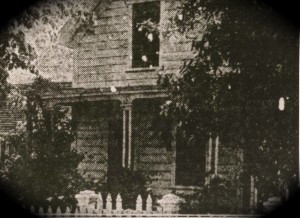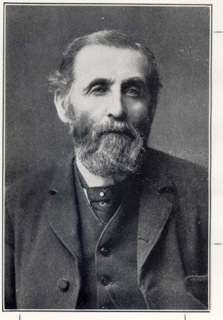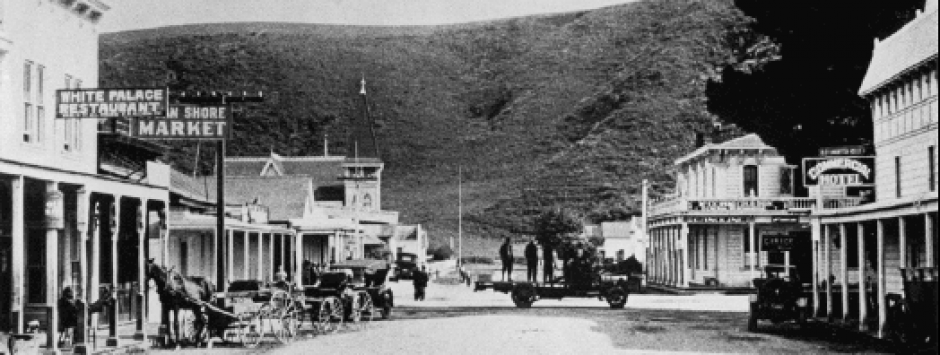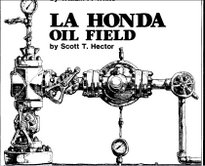Part I
Story by John Vonderlin
Hi June,
This is an amazing article from the July 28th, 1865, issue of “The Daily Alta.” Having lived one summer in the wilds on the Mattole River, just north of the “Lost Coast,” and west of the town of Petrolia, in Humboldt County, I had been aware that California’s first oil well was drilled there. That was the same year this article was written. Why the information about Pescadero, this article contains is not well known, let alone trumpeted by civic boosters is quite peculiar. I know nothing about the sceptical and ever so wrong, Professor Brewer, any of the land owners mentioned, or the reporter Mr. Harnett, but will investigate further.
The tiny, blurred type of this nearly one hundred and fifty year old newspaper article made for a lot of OCR errors, but I’m excited about doing Part 2, which appeared some months later. Note that Pescadero was in Santa Cruz County at this time, as the boundary adjustment that produced the present counties’ borders wasn’t done until 1868.
Enjoy. John
SANTA CLARA AND SANTA CRUZ OIL LANDS – NO. 1
THE PETROLEUM QUESTION
Editors Alta: Up to this period, with one slight exception, I have taken no part in the discussion of our State being, or not being, an oil producing country. To me it has ever appeared an insult to educated intelligence, as well as to practical .experience, to maintain the negative. Were the existence of petroleum a modern discovery, confined to the Atlantic States, or were our local indications of its existence less extensive, or less reliable than they are, there would be little rational argument against its existence in California as a question of science; but, having been used for a variety of purposes in the earliest ages of the world, and having been found in every quarter of the globe at the present day, there appeared to me to be none, and indeed there can be none. The problems worked out in the laboratory of nature are never wrong. Wherever she indicates reliably the existence of a mineral, labor, if directed and controlled by scientific principles, soon renders the presumption a reality. If surface evidences are reliable in gold, silver, and copper, for instance, why should they not be believed in oil? As a matter of science, or experience, would it not be preposterously absurd to maintain the negative of such a proposition, and ignore the principles by which our actions in both have been governed from time immemorial? If rock is auriferous, we seek and find gold; if argentiferous, we seek and find silver; if cupriferous, we seek and find copper; if oleaginous, who shall say we ought not to seek and find oil? Professor Brewer? Then that gentleman makes himself wiser than the world, a conclusion in which the people of California by no means concur now.
INCREDULITY
It is difficult to understand the silly incredulity we have shown in this matter, because one man of reputation and position has chosen to say, ex cathedra, that asphalt is no evidence of oil. Without taking exception to this theory, which by the way is very questionable, our claims to having an oil-bearing country do not rest on that point. Tbe intelligent and practical observer, much less tbe professional explorer, will find in our coast range such evidence of petroleum outside the asphalt, that the most sceptical must be convinced. Within the limits of my own travels on the upper ranges of the coast, extending fifteen hundred miles north and south, and from fifty to seventy east and west, I everywhere found such natural indications on the surface, that it seemed to me simply ridiculous to doubt the existence of oil in quantity underneath. To-day, public opinion has changed from what it was a month ago. The recent developments at Humbodt, and elsewhere, though obtained at a very small expenditure of labor and capital, have swept the incredulity from our midst, and compelled the people to recognise the proven fact, that our State is as rich in oil, as in gold, silver, or copper. I have waited with impatience, but not without confidence, for this change. because until then a man could do little good by writing upon our oil interests. No matter what he found, or how honestly speak, the public would not attach tbe same importance to his communications that they will now, and thus he would probably injure rather than benefit the districts he sought to serve. All would be regarded as vague, problematical, speculative, to be forgotten as soon as read, or perhaps not read at all.
But now, as tbe public are prepared to receive facts as facts, and principles as principles, inevitable in their laws and relations, and to see a great commercial interest springing out of the oil business; I propose to give a series of letters on the “oileoligy” of these counties, whose claims to notice are second to none in the State, but which, so far, have been entirely overlooked. I shall commence with
PESCADERO.
This little town, as it name implies is of Spanish origin, lying on the ocean, about forty miles south of San Francisco. It is easy of access by three different routes-by steam in tha Salinas, by stage from San Mateo, or by Horseback or buggy from Santa Clara, the expense of either being only a few dollars. The most convenient route at present is from Santa Clara, where the traveller is advised to put himself under the care and direction of Mr. Cameron, of the hotel, who will supply all his wants in the most liberal and excellent style. From this town to the oilregion is about twenty-five miles, through as charming a country of valley and mountain as the world produces. On crossing the summit, the ocean opens to view on the west side, the bay and valley on the east, with Goat Island looming up distinctly in the distance, unfolding in an instant one of tho finest conceptions of the grandeur and immensity of distance the mind can contemplate. Thence to the oil ground you begin to descend the great sink to its ocean outlet, where the fluid has collected and wasted for centuries, with towering forests of redwood in front, and well cultivated ranches on the rolling slopes on every side. At the bottom of this ridge lies Tar Water Creek, where the Oilwas first found.
We hear great accounts, from Humboldt and the far south, of splendid discoveries, showing that with oil, like gold, “distance still lends enchantment to the view.” These accounts I am satisfied are correct; but, for all that, we have quite as good springs at our own doors, and, moreover, possessing numberless advantages the others do not, of which I shall speak more fully hereafter? The Tomkins, Gurnsey Co. location eight years ago discharged a volume six or eight inches of liquid asphalt continually, but is now covered by a slide. This liquid has been boiled for sixteen consecutive hours, becoming more limpid to the last. At times the escape of gas is so terrible as to shake the house like an earthquake. The formation is excellent: sandstone, with shale walls, lying horizontal from here to the Rowley claim, aome four hundred yards below, the oil seeps from the banks all the way on both sides of the creek, while the loose, fragmentary rock, lying in the water, is so saturated with oil, that it has become black, breaking like bread, and burning like dry wood. The Rowley claimis a fac simile (sic) of thaepreceding, with a large, open, deep well of liquid asphaltum still existing, from which it runs down the creek at times. besmearing everything it rolls over. I have heard the gas escape here so strongly that it sounded as if men were shooting off Colt’s navy revolvers. Both these locations possess the finest advantages for boring with effect. One hundred and fifty feet depth will make a splendid development. From here to Pescadero Creek, perhaps two miles, are other locations of merit. On that stream the asphalt disappears altogether, and the indications become more naphthalic. The rock also is finer and whiter, exhibiting almost pure oil. The banks, in places, are so saturated that a handfull of sand will nearly all float down the stream, scarcely a third of it sinking. Can Humboldt or anywhere else beat that? I state these facts, marvellous as they may seem, on my personal responsibility. I do not recollect the names of the parties owning this location. All this land up and down the creek is preempted. At the junction of Jones Creek and Pescadero, Mr. Mars, late of the United States Branch Mint, made a very fine location, and beyond him on the main branch of Jones Creek, comes Mr. Smith, of San Francisco, with an equally good claim. These are all in this section of which I have personal knowledge. lam told, however, that claims equally good, though more difficult of access, have been preempted to the headwaters and down to the mouth of Pescadero Creek. Next to the vast amount of oil this land indicates in every direction, the grand advantage over all others is its proximity to the ocean and the commercial city of the State. Steam by water or rail will bring the oil to our stores in San Francisco, with the expenditure of $2,000 for roads either way, while the climate and produce cannot be surpassed. Who can predict tbe growth of Pescadero in five years’ time, when this adjacent land, pours forth its hidden wealth? Already a a favorite resort in Summer, it will inevitably become the most extensive, fashionable, and wealthy town on the southern coast. Permit me in conclusion, through your columns, publicly to. acknowledge my gratitude to Dr. Tomkins. Mr. Cameron. Mr. Rowley, Mr. Jones and others, for attentions and hospitalities I cannot forget. San Jose. July 25th. LEON HARNETT



